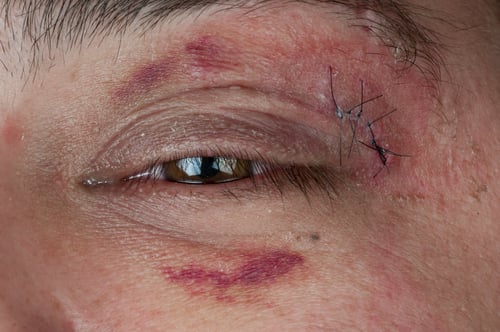Tips for keeping your eyes safe while at home and out and about.
Earlier this week as part of National Eye Injury Prevention Month, we talked about the importance of keeping your eyes safe and protected while you are at work, especially if you are exposed to different types of dangerous chemicals or hazardous materials on a regular basis. However, while an alarming number of serious eye injuries do occur in the work place each year, another 44% happen while you are away from work.
Eye burns or injuries caused by dangerous chemicals do not only happen around workplace hard hats and lab coats. Many of these dangerous chemicals that pose a serious threat to our vision can be found under out kitchen sinks, in our garage, or even in our bathroom. Even every day activities such as mowing the lawn or wrestling in the backyard with your children have the potential to kick up foreign objects into your eyes.
Therefore, to help ensure that you keep your eyes protected at home and when you are out and about, here are a few tips for keeping your eyes safe each and every day:
Keep Safety Eyewear Around The House
Often times the reason why many people will skip eyewear when it comes to tackling a hazardous project or cleaning the house up with dangerous chemicals is because they simply do not have any eyewear at home. The recommendation from both the American Academy of Ophthalmology and the American Society of Ocular Trauma is that every home should own a pair of protective eyewear, as more than 90% of all eye injuries can be prevented through the use of them.
According to the U.S. Department of Health and Human Services’ Federal Occupational Health department, some regular home activities that should require wearing protective eyewear include:
- Doing work that may produce particles, slivers, or dust from materials like wood, metal, plastic, cement, and drywall
- Hammering, sanding, grinding, or doing masonry work
- Working with power tools
- Working with chemicals, including common household chemicals like ammonia, oven cleaners, and bleach
- Using a lawnmower, riding mower, or other motorized gardening devices like string trimmers (also called “weed wacker” or “weed whip”)
- Working with wet or powdered cement
- Welding (which requires extra protection like a welding mask or helmet from sparks and UV radiation)
- “Jumping” the battery of a motor vehicle
- Being a bystander to any of the above
Identify Possible Risks Before Beginning Any Activity
Just as we mentioned earlier this week that it is important to always asses risks in the workplace, you should also do the same before beginning any possibly dangerous activities at home. For instance, before you begin a new project, activity or cleaning session, clear out the area of any debris or clutter that could cause an eye injury. You should also do the same with lawn and gardening projects, as this typically involves kicking up a lot of dust, dirt and debris into the area you are working in.
For more information about National Eye Injury Prevention Month, be sure to check out our previous blog post on keeping your eyes safe in the workplace! Also stay tuned to the OCLI blog post for the rest of the month for more posts on National Eye Injury Prevention Month.
Research: Source
